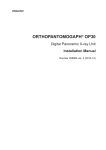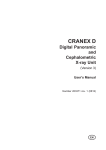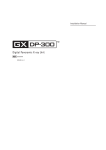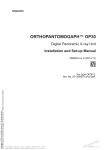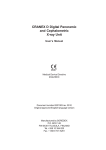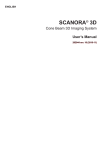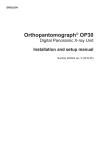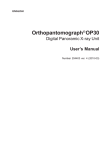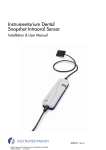Download ORTHOPANTOMOGRAPH® OP30
Transcript
ENGLISH ORTHOPANTOMOGRAPH® OP30 Digital Panoramic X-ray Unit User Manual Number 208677 ver. 1 (2012-06) ORTHOPANTOMOGRAPH® OP30 Copyright Contents Document code: 208677 ver. 1 (2012-06) Copyright © 2012 by PaloDEx Group Oy. All rights reserved. Documentation, trademark and the software are copyrighted with all rights reserved. Under the copyright laws the documentation may not be copied, photocopied, reproduced, translated, or reduced to any electronic medium or machine readable form in whole or part, without the prior written permission of Instrumentarium Dental. The original language of this manual is English. Instrumentarium Dental reserves the right to make changes in specification and features shown herein, or discontinue the product described at any time without notice or obligation. Contact your Instrumentarium Dental representative for the most current information. ORTHOPANTOMOGRAPH® is a registered trademarks of Instrumentarium Dental. CLINIVIEWTM is a common law trademark of Instrumentarium Dental. Manufactured by Instrumentarium Dental, PaloDEx Group Oy. Nahkelantie 160 (P.O. Box 20) FI-04300 Tuusula FINLAND Tel. +358 (0)10 270 2000 Fax. +358 9 851 4048 For service, contact your local distributor. User Manual 208677 iii ContentsORTHOPANTOMOGRAPH® OP30 iv User Manual 208677 ORTHOPANTOMOGRAPH® OP30 Contents Contents 1. Introduction ........................................................................................................ 1 1.1 ORTHOPANTOMOGRAPH® OP30 X-ray unit............................................... 1 1.2 About this manual........................................................................................... 2 2. Unit description.................................................................................................. 3 2.1 Main parts...................................................................................................... 3 2.2 Unit controls................................................................................................... 5 2.3 Accessories.................................................................................................... 6 3. Using the Unit..................................................................................................... 7 3.1 Preparing the Unit.......................................................................................... 7 3.2 Taking Exposures......................................................................................... 10 Panoramic standard, paediatric and bitewing............................................ 10 Temporomandibular Joint (TMJ)................................................................ 19 4. Operating the unit without generating x-rays................................................ 25 5. Unit settings...................................................................................................... 26 5.1 Opening the Setup window.......................................................................... 26 5.2 The Device page.......................................................................................... 27 Status field................................................................................................. 27 Retrieve Last Image field........................................................................... 27 Device Serial Number field........................................................................ 28 6. Troubleshooting and Maintenance................................................................. 29 6.1 Error messages and symbols....................................................................... 29 Error symbols............................................................................................. 30 User errors................................................................................................. 31 System errors............................................................................................ 31 6.2 Care and Maintenance ................................................................................ 33 Cleaning and disinfecting the unit.............................................................. 33 Surfaces that the patient touches...................................................... 33 Unit surfaces..................................................................................... 33 Positioning mirror and light lenses.................................................... 33 Touch screen control panel............................................................... 33 Correct operation of the unit...................................................................... 34 Yearly maintenance................................................................................... 35 7. Warnings and precautions.............................................................................. 36 7.1 General warnings......................................................................................... 36 7.2 User / patient warnings................................................................................ 37 8. Disposal............................................................................................................ 40 Appendix A. Technical Information....................................................................A-1 User Manual 208677 v ContentsORTHOPANTOMOGRAPH® OP30 vi User Manual 208677 ORTHOPANTOMOGRAPH® OP30 1. Introduction 1. Introduction 1.1 ORTHOPANTOMOGRAPH® OP30 X-ray unit The ORTHOPANTOMOGRAPH® OP30 (the unit) is a digital panoramic dental x-ray unit designed to take: - standard panoramic exposures, - paediatric panoramic exposures (reduced width) - bitewing exposures - and TMJ exposures. The unit uses a CCD sensor as the image receptor and a PC with suitable (MDD complient) dental imaging software, such as CLINIVIEWTM, for image acquisition and handling. The unit can be used in single or multiple user configurations. With the single user configuration the unit is connected to a single PC. With the multiple user configuration (Easy Share activated) the unit is connected to a network where up to eight PCs can be connected to the unit. With the Easy Share configuration only one PC at a time can reserve and use the unit. IMPORTANT NOTE: Before using the unit for the first time, make sure that it is set up to your requirements. See section 5. Unit Settings. USA only Caution: Federal law restricts this device to sale by or on the order of a dentist or other qualified professional. User Manual 208677 1 1. Introduction ORTHOPANTOMOGRAPH® OP30 1.2 About this manual This manual describes how to use and set up the unit. Please read these instructions carefully before operating the unit. Before operating the unit, please read and observe the warnings and precautions that appear in section 7. Warnings and Precautions. 2 User Manual 208677 ORTHOPANTOMOGRAPH® OP30 2. Unit description 2. Unit description 2.1 Main parts 1Column 2 Upper shelf 3 Rotating unit 4 Emergency stop button - Press to stop, rotate to release. 5 On / off switch (rear of column) 6 PC with MDD compliant dental imaging software User manual 208677 3 2. Unit description ORTHOPANTOMOGRAPH® OP30 1 Exposure warning light 2 Midsagittal light 3Mirror 4 Frankfort light and light positioning knob 5 Focal trough positioning knob 6 Patient support 7 Focal trough light 8 Patient support handles 9 Head support 4 User manual 208677 ORTHOPANTOMOGRAPH® OP30 2. Unit description 2.2 Unit controls 1 2 3 4 A. Side control panel Lights key - switches the positioning lights on and off. Up key - drives the unit up. Down key - drives the unit down. Return key - drive the unit to the patient in/out position (PIO). 5 6 7. 8. 9. 10 11. 12 13 B. Main control panel Program selection keys: - P1 = standard pan, P2 = paediatric pan, P3 = TMJ, BW = bitewing. Patient size selection keys: - Child, Juvenile, Adult, Large adult: Manual (M) mode selection key. kV and mA selection keys, manual mode only. Test key - operates the unit without x-rays. Exposure values. Service key. Dose Area Product (DAP). Unit status indicator. User manual 208677 5 2. Unit description ORTHOPANTOMOGRAPH® OP30 2.3 Accessories Chin rest Bite block Bite fork 71 mm Chin support Edentulous bite positioner Nose support long - for children Nose support short - for adults 6 User manual 208677 ORTHOPANTOMOGRAPH® OP30 3. Using the Unit 3. Taking an Exposure IMPORTANT NOTE: If the unit is being used for the first time or if you are using the unit for the first time check that it is set up to your requirements. See section 5. Unit Settings. 3.1 Preparing the Unit 1. PC: Switch on the PC that is connected to the unit. 2. PC: Open CLINIVIEWTM or the dental imaging software you are using and enable image capture. Refer to the instructions supplied with the dental imaging software for information on how to do this. 3. Switch the unit on. The on/off switch is at the rear of the column near the base. The unit display will come on and the unit will carry out a self test. When the self test is complete a question mark (?) will appear next to the unit status indicator. This indicates that you need to reserve the unit before you can take an exposure. Single user: Multiple users: User manual 208677 7 3. Taking an Exposure ORTHOPANTOMOGRAPH® OP30 NOTE: If the no connection symbol (X) appears next to the unit status indictor, it indicates that there is no connection between the unit and the PC. See section “Troubleshooting and Maintenance” for more information. 4. PC: Press the device icon to reserve the unit and enable image capture. NOTE: If a message appears stating that the unit is in use it indicates that the unit has been reserved by another user. INFORMATION: The status of the unit, available, ready or busy can be seen in the status field at the bottom of the PC display. 5. When the unit status indictor turns GREEN and the text Ready appears the unit is ready to take an exposure. Single user: Multiple users: 8 User manual 208677 ORTHOPANTOMOGRAPH® OP30 3. Taking an Exposure 6. Press the Return key to drive the rotating unit to the Patient In/Out (PIO) position. User manual 208677 9 3. Taking an Exposure ORTHOPANTOMOGRAPH® OP30 3.2 Taking Exposures Panoramic standard, paediatric and bitewing 1. Slide the chin rest on to the support holder. 2. Dentate patients. Attach the bite block to the bite fork and then insert the bite fork and bite block into the hole in the chin rest. Edentulous patients (panoramic standard and paediatric only). Attach the chin support to the chin rest. If the patient is partially edentulous attach the edentulous bite positioner to a bite fork and then insert the bite fork and edentulous bite positioner into the hole in the chin rest. 3. Place the appropriate disposable covers on to the patient support you are using. 10 User manual 208677 ORTHOPANTOMOGRAPH® OP30 3. Taking an Exposure 4. Select the panoramic program you require, standard panoramic (P1), paediatric panoramic (P2) or bitewing (BW). The magnification for these programs is 1.25. 5. Select the patient size, Child, Juvenile or small adult, Adult or Large adult. Default kV and mA values for the selected patient size will appear on the display. The DAP value for the selected program and patient size will appear on the display. If you consider that the default kV and mA values are not correct for the patient being examined select different values based on the patient’s size, age and estimated bone density. To select different kV and mA values press the M key. Plus (+) and minus (-) keys will appear. These allow you to change the kV and mA values to suit the patient being examined. The recommended values are: - Child, 66 kV - Juvenile or small adult, 70 kV - Adult, 73 kV - Large Adult, 77 kV User manual 208677 11 3. Taking an Exposure ORTHOPANTOMOGRAPH® OP30 6. Ask the patient to remove any spectacles, dentures, jewellery and hair clips and pins. Place a protective lead apron around the patient’s neck to protect the patient’s thyroid gland from radiation. NOTE: If the patient is nervous, you can reassure him/ her by demonstrating how the unit works before taking the exposure. See section 4. Operating the unit without x-rays. 7. Press the Up/Down keys to adjust the height of the chin rest so it is slightly higher than the patient’s chin so that the patient will have to stretch up to place their chin on the chin rest. 8. If the patient is dentate ask the patient to step into the unit, grasp the patient handles, place his/her chin on the chin rest and bite the notches in the bite block. If the patient is partially edentulous ask the patient to bite the edentulous bite positioner. 12 User manual 208677 ORTHOPANTOMOGRAPH® OP30 3. Taking an Exposure If the patient is edentulous ask the patient press chin against the chin support. 9. Press the Lights key to switch the patient positioning lights on. They will remain on for two minutes. NOTE: The patient positioning lights will automatically come on when either the Up or Down key is pressed. 10.Look at the reflection of the patient in the mirror and position the midsagittal plane of the patient so that it coincides with the midsagittal plane light. Make sure that the patient is looking straight ahead and that the patient’s head is not tilted or turned to one side. User manual 208677 13 3. Taking an Exposure ORTHOPANTOMOGRAPH® OP30 11.Press either Up/Down key to adjust the tilt of the patient’s head. For a standard or paediatric panoramic exposure position the patient so that the Frankfort plane coincides with, or is parallel to, the horizontal light. For a bitewing exposures position the patient so that the Occlusal plane coincides with, or is parallel to, the horizontal light. CAUTION: When pressing the Up/Down keys to adjust the tilt of the patient’s head make small adjustments only so as not to cause the patient any distress or discomfort. 12.The focal trough light indicates the center of the focal trough which is 10 mm wide at the front. Ask the patient to open their lips so that you can see the patient’s teeth. For standard panoramic (P1) and paediatric panoramic (P2) panoramic exposures use the focal trough knob to position the patient so that the focal trough light is in the center of the patient’s upper and lower third teeth (canines). 14 User manual 208677 ORTHOPANTOMOGRAPH® OP30 3. Taking an Exposure The roots of the upper and lower front incisors must be located within the focal trough and be on the same vertical plane. If the roots of the upper and lower front incisors are not on the same vertical plane adjust the tilt of the patient’s head until they are. For bitewing (BW) panoramic exposures position the chinrest on the BW line. User manual 208677 15 3. Taking an Exposure ORTHOPANTOMOGRAPH® OP30 13.Close the temple supports by sliding the temple support knob to the right (A). Make sure that patient’s neck is stretched and straight. Adjust the position of the nasion support (B) and then carefully push the forehead support in until it touches the patient’s nasion (C). 14.Ask the patient to press their lips together and press their tongue against the roof of their mouth. Then ask the patient to look at a fixed point in the mirror and to remain still for the duration of the exposure. The exposure takes approximately ten seconds. 15.Ask the patient to step forward slightly so that they out of balance and “hanging” onto the support handles. This will force the patient to stretch their neck as far a possible. Check that the patient has not moved and is still in the correct position. 16.Make sure that the unit status indicator is still GREEN, indicating that the unit is ready to take an exposure. If the indicator is not GREEN the unit reservation time may have expired. Reserve the unit again, see section “3.1 Preparing the unit”. 16 User manual 208677 ORTHOPANTOMOGRAPH® OP30 3. Taking an Exposure 17.Move at least two metres away from the unit and protect yourself from radiation. Make sure that you can see and hear the patient during the exposure. 18.Press and hold down the exposure button for the duration of the exposure. The exposure starts when you hear the exposure warning signal and the exposure warning indicator (control panel) and light (side of the unit) come on. The rotating unit will rotate around the patient’s head and take the exposure. When the exposure warning signal and rotating unit stop, the exposure has been taken. 19.Press the release button at the top of the forehead support (A) and then slide the forehead support away from the patient (B). Open the temple supports by sliding the temple support knob to the left (C). Guide the patient out of the unit. User manual 208677 17 3. Taking an Exposure ORTHOPANTOMOGRAPH® OP30 20.Press the Return key to drive the unit to the PIO position. NOTE: After the exposure, a timer indicating the tubehead cooling time will appear on the display. A new exposure cannot be taken until the counter reaches zero, the exposure time reappears on the display and the unit status indicator comes on. 21. PC: After the exposure has been taken a progress bar will appear. This indicates that the image is being transferred to the PC. 18 User manual 208677 ORTHOPANTOMOGRAPH® OP30 3. Taking an Exposure Temporomandibular Joint (TMJ) 1. Slide the nose support into the support holder. Use the short version for adults and the long version for children. 2. Place a disposable cover on to the nose support. 3. Press the TMJ key (P3) to select TMJ program. The magnification is 1.25. 4. Select the patient size, Child, Juvenile or small adult, Adult or Large adult. Default kV and mA values for the selected patient size will appear on the display. The appropriate DAP value will appear on the display. If you consider that the default kV and mA values are not correct for the patient being examined select different values based on the patient’s size, age and estimated bone density. User manual 208677 19 3. Taking an Exposure ORTHOPANTOMOGRAPH® OP30 To select different kV and mA values press the M key. Plus (+) and minus (-) keys will appear. These allow you to change the kV and mA values to suit the patient being examined. The recommended values are: - Child, 66 kV - Juvenile or small adult, 70 kV - Adult, 73 kV - Large Adult, 77 kV 5. Use the focal trough knob and position the support holder so that it is -5 for an adult and 0 for a child. 6. Ask the patient to remove any spectacles, dentures, jewellery and hair clips and pins. Place a protective lead apron around the patient’s neck to protect the patient’s thyroid gland from radiation. 20 User manual 208677 ORTHOPANTOMOGRAPH® OP30 3. Taking an Exposure NOTE: If the patient is nervous you can reassure him/ her by demonstrating how the unit works before taking the exposure. See section 4. Operating the unit without x-rays. 7. Press the Up/Down keys to adjust the height of the nose support so that the top is level with the patient’s upper lip. 8. Ask the patient to step into the unit, grasp the patient handles and press their top lip against the top of the nose support. 9. Press the Lights key to switch the patient positioning lights on. They will remain on for two minutes. NOTE: The patient positioning lights will automatically come on when either the Up or Down key is pressed. 10.Look at the reflection of the patient in the mirror and position the midsagittal plane of the patient so that it coincides with the midsagittal plane light. Make sure that the patient is looking straight ahead and that the patient’s head is not tilted or turned to one side. User manual 208677 21 3. Taking an Exposure ORTHOPANTOMOGRAPH® OP30 11.Press either Up/Down key to adjust the tilt of the patient’s head until the patient’s Frankfort plane coincides with, or is parallel to, the horizontal light. CAUTION: When pressing the Up/Down keys to adjust the tilt of the patient’s head make small adjustments only so as not to cause the patient any distress or discomfort. 12.Close the temple supports by sliding the temple support knob to the right (A). Make sure that patient’s neck is stretched and straight. Adjust the position of the nasion support (B) and then carefully push the forehead support in until it touches the patient’s nasion (C). 13.Check once more that the patient is positioned correctly and has not moved. 14.If you are taking a TMJ exposure with the patient’s mouth closed ask the patient to clench their back teeth together, look at a fixed point in the mirror and to remain still for the duration of the exposure. 22 User manual 208677 ORTHOPANTOMOGRAPH® OP30 3. Taking an Exposure If you are taking a TMJ exposure with the patient’s mouth open, ask the patient to open their mouth, look at a fixed point in the mirror and to remain still for the duration of the exposure. The exposure takes approximately ten seconds. 15.Make sure that the unit status indicator is still GREEN, indicating that the unit is ready to take an exposure. If the indicator is not GREEN the unit reservation time may have expired. Reserve the unit again, see section “3.1 Preparing the unit”. 16.Move at least two metres from the unit and protect yourself from radiation. Make sure that you can see and hear the patient during the exposure. 17.Press and hold down the exposure button for the duration of the exposure. The exposure starts when you hear the exposure warning signal and the exposure warning indicator (control panel) and light (side of the unit) come on. The rotating unit will rotate around the patient’s head and take the exposure. When the exposure warning signal and rotating unit stop, the exposure has been taken. User manual 208677 23 3. Taking an Exposure ORTHOPANTOMOGRAPH® OP30 18.PC: After the exposure has been taken a progress bar will appear. This indicates that the image is being transferred to the PC. 19.If you wish to take a second TMJ exposure, press the Return key to drive the unit back to the PIO position, enable image capture (PC) and then reposition the patient and take the second exposure steps 13 -15. 20.Press the release button at the top of the forehead support (A) and then slide the forehead support away from the patient (B). Open the temple supports by sliding the temple support knob to the left (C). Guide the patient out of the unit. 21.Press the Return key to drive the unit to the PIO position. 24 User manual 208677 ORTHOPANTOMOGRAPH® OP30 4. Operating the unit without x-rays 4. Operating the unit without generating x-rays In some situations, for example with nervous patients or patients with unusual anatomy, you may wish to operate the unit without generating x-rays before taking an exposure. Press the T key (Test), the exposure values on the display will clear. The exposure switch can now be pressed to demonstrate how the unit operates without x-rays being generated. Press the T key a second time to return to the normal exposure mode. NOTE: After switching the unit off and then on again the unit returns to the normal (exposure) mode. User manual 208677 25 5. Unit Set up ORTHOPANTOMOGRAPH® OP30 5. Unit settings 5.1 Opening the Setup window 1. PC: Open CLINIVIEWTM or the dental imaging software you are using. 2.Select Tools and then click OP30 Settings. 3.The OP30 Setup window will appear. 26 User manual 208677 ORTHOPANTOMOGRAPH® OP30 5. Unit Set up 5.2 The Device page Status field Device indicates whether the unit is connected to the PC. Version: shows the software version of the unit and Serial No: the serial number of the unit. Retrieve Last Image field If the last image taken is not transferred to the PC because of a network, PC or software failure, the image can be retrieved from the unit memory. IMPORTANT NOTE The last image can only be retrieved if the unit is left on after the last exposure was taken. If the unit is switched off the image will be lost. To retrieve the last image: A. Correct the problem that caused the network, PC or software failure, and then reopen the patient card. User manual 208677 27 5. Unit Set up ORTHOPANTOMOGRAPH® OP30 B. The last image taken should be automatically transferred. If it is not, click the Retrieve now button to retrieve the last image taken by the unit. C. Click OK to close the OP30 Setup window. The last image taken will appear on the patient card. Device Serial Number field Click the Add serial number ... check box and the serial number of the unit will be added to all new images. The serial number will appear in the top left-hand corner and the bottom righthand corner of the image. 28 User manual 208677 ORTHOPANTOMOGRAPH® OP30 6. Troubleshooting and Maintenance 6. Troubleshooting and Maintenance 6.1 Error messages and symbols If the unit is not used correctly or the unit malfunctions an error message or symbol will appear on the unit display. There are three groups of error message: - Error symbols The symbol will clear when the problem is corrected. - H, user errors - E (Error), exposure errors, these occur during exposure. These all appear on the unit display. Touch the CLEAR button to clear the error message and return to the main display. NOTE: If the CLEAR button does not appear on the error message display you will have to wait for the error to clear automatically. User manual 208677 29 6. Troubleshooting and Maintenance ORTHOPANTOMOGRAPH® OP30 Error symbols REASON i. The PC connected to the unit is not on. ii. The dental imaging software in the PC is not open. iii. The cable connecting the unit to the PC is disconnected or damaged. iv. The IP address is not set correctly. SOLUTION i. Switch the PC on. ii. Open the dental imaging software and select a patient. iii. Reconnect the cable. If damaged, contact service. iv. Reconfigure the IP address. REASON The emergency stop button is pressed down in the STOP position. SOLUTION Rotate and release the emergency stop button. The error symbol will clear. 30 User manual 208677 ORTHOPANTOMOGRAPH® OP30 6. Troubleshooting and Maintenance User errors H1 REASON The exposure button was released during an exposure. SOLUTION Clear the error message and check if the attempted exposure is sufficient for the diagnostic task. If it is not, take a new exposure. If the exposure failed while the exposure button was still being pressed, check the exposure switch by taking a test exposure without patient to see if the exposure button is defective or not. If the same problem occurs again, contact service. System errors E4 REASON Tubehead too hot or too cold. SOLUTION When the error message automatically clears the tubehead has reached the correct operating temperature. In normal conditions this will take about 30 minutes for the tubehead to reach the correct temperature. If the error message does not disappear within a reasonable amount of time, contact service. E5 REASON Line voltage not within limits. SOLUTION If the error message reappears it indicates that the voltage is not within limits. The error message will automatically clear when the voltage returns to then correct level. If the error message keeps on appearing or does not disappear within a reasonable amount of time, contact service. User manual 208677 31 6. Troubleshooting and Maintenance ORTHOPANTOMOGRAPH® OP30 E19 REASON Exposure switch stuck down during unit start. SOLUTION Switch the unit off and check that the exposure switch is not stuck in the exposure position. Switch the unit on again. If the message reappears, contact service. Exx (all other E errors except E4, E5 and E19 (above). SOLUTION Clear the error message and try to take an exposure without a patient. If the error message reappears, switch the unit off, wait for half a minute and then switch the unit on again. If the error message reappears contact service. 32 User manual 208677 ORTHOPANTOMOGRAPH® OP30 6. Troubleshooting and Maintenance 6.2 Care and Maintenance Cleaning and disinfecting the unit Warning Switch the unit off before cleaning it. Surfaces that the patient touches All surfaces and parts that the patient touches or comes into contact with must be disinfected after each patient. Use a disinfectant that is formulated specifically for disinfecting dental equipment and use the disinfectant in accordance with the manufacturer’s instructions. Unit surfaces Use a soft cloth dampened with a mild detergent/ disinfectant to clean unit surface. DO NOT use abrasive cleaning agents or polishes on the unit. Positioning mirror and light lenses The positioning mirror is made of glass and the focal trough positioning light cover is made of plastic. Use a soft cloth dampened with a mild detergent. NOT use abrasive cleaning agents or polishes on these parts. Touch screen control panel If the surface of the control panel becomes soiled, clean it with absorbent cotton or other soft cloth. Remove any drops of liquid from the control panel surface immediately. Prolonged contact with liquid may cause the surface of the control panel to discolor or spots to appear. User manual 208677 33 6. Troubleshooting and Maintenance ORTHOPANTOMOGRAPH® OP30 Correct operation of the unit If any of the unit’s controls, displays or functions fail to operate or do not operate in the way described in this manual, switch the unit off, wait 30 seconds and then switch the unit on again. If the unit still does not operate correctly contact your service technician for help. If you hear the exposure warning tone but the exposure warning light on the display does not come on when an exposure is taken, stop using the unit and contact your service technician for help. If you do not hear the exposure warning tone when an exposure is taken, stop using the unit and contact your service technician for help. Every week check that the power supply cable is in good order (not damaged in any way) and that the unit operates correctly in accordance with the instructions in this manual. Make sure that the unit cannot be driven up/down when the emergency stop button has been pressed down. 34 User manual 208677 ORTHOPANTOMOGRAPH® OP30 6. Troubleshooting and Maintenance Yearly maintenance Once a year an authorized service technician must carry out a full inspection of the unit. The following tests and checks must be carried out: – a kV/mA test – a beam alignment test – check that the safety ground is connected – check that the positioning lights operate – check that no oil is leaking from the tube head – check that the power lead is not damaged in any way. – check that all covers and mechanical parts are correctly secured and have not come loose. – check that any vents in the covers are not blocked with dust and that no dust has accumulated inside the unit. A full description of all the tests and checks is described in the Service Manual. User manual 208677 35 7. Warnings and precautions ORTHOPANTOMOGRAPH® OP30 7. Warnings and precautions 7.1 General warnings • The unit must only be used to take the dental x-ray exposures described in this manual. The unit must NOT be used to take any other x-ray exposures. It is not safe to use the unit to take an x-ray exposure that the unit is not designed to take. • The unit must only be used by personnel qualified and experienced in the use and operation of digital panoramic dental x-ray devices. • If this device will be used with 3rd party imaging application software not supplied by Instrumentarium Dental, the 3rd party imaging application software must comply with all local laws on patient information software. This includes, for example, the Medical Device Directive 93/42/EEC and/or FDA if applicable. • Do not connect any device to the unit that has not been supplied with the unit or that is not recommended by Instrumentarium Dental. • The unit or its parts must not be changed or modified in any way without approval and instructions from Instrumentarium Dental. • The unit should not be used adjacent to or stacked with other equipment. • This unit can interfere with other devices due to its EMC characteristics and other devices can interfere with this unit due to their EMC characteristics. Refer to the EMC Declaration (A4) in Appendix A for more information. 36 User manual 208677 ORTHOPANTOMOGRAPH® OP30 7. Warnings and precautions 7.2 User / patient warnings User manual 208677 • The unit may be dangerous to the user and the patient, if the safety regulations in this manual are ignored, if the unit is not used in the way described in this manual and/or if the user does not know how to use the unit. • Because the x-ray limitations and safety regulations change from time to time, it is the responsibility of the user to make sure that all the valid safety regulations are fulfilled. • It is the responsibility of the user to decide if the x-ray exposure is necessary. • Always use the lowest suitable x-ray dose to obtain the desired level of image quality. • Always use suitable hygienic barriers on parts of the unit that the patient has contact with. • Avoid taking x-ray exposures of pregnant women. • If the patient is using a pacemaker, consult the manufacturer of the pacemaker to confirm that the x-ray unit will not interfere with the operation of the pacemaker before taking an exposure. • The user of the unit must stand at least two meters away from the unit AND protect him/herself from radiation when taking exposures. It is recommended that a moveable radiation protection screen is used to protect the user. The radiation protection screen should be located so that the user is able to see the control panel and patient from behind the radiation protection screen (the protected area or control zone). 37 7. Warnings and precautions ORTHOPANTOMOGRAPH® OP30 The radiation protection screen must be large enough to fully protect the user from radiation. The radiation protection area must be at least 60 cm wide, 60 cm deep and 200 cm high. The radiation protection screen must include lead shielding with a minimum thickness 0.5 mm and the screen must conform to all national regulations concerning radiation shielding of dental/medical devices. • The user must be able to see and hear the patient at all times during an exposure. • The user must be positioned so that he/she can see the exposure warning light/indicator and hear the audio exposure warning signal during the exposure. If the unit is installed in such a place where the exposure warning light/indicator cannot be seen or the audio exposure warning signal cannot be heard, then a separate exposure warning light/indicator device should be used. Please contact your local service for help. 38 User manual 208677 ORTHOPANTOMOGRAPH® OP30 User manual 208677 7. Warnings and precautions • Disinfect all the surfaces that the patient is in contact with after every patient. • If the unit does not appear to be working correctly, switch the unit off and release the patient. Make sure that the unit operates correctly before you continue using it. If you are not sure whether the unit is operating correctly, please contact your local service for help. • If the unit will not be used for a long time, switch the unit off in order to prevent unauthorized people using the unit. • Do not use the unit if any of its covers or parts are damaged, loose or have been removed. Contact a service person approved by Instrumentarium Dental and get them to repair or replace any damaged, loose or removed covers or parts before reusing the unit. • When touching the patient do not touch any electrical or Ethernet connectors at the same time. • Do not touch or operate the unit if the unit is being serviced or if the covers have been removed for any reason. 39 8. Disposal 8. Disposal ORTHOPANTOMOGRAPH® OP30 At the end of useful service life of the device, its spare parts, its replacement parts and its accessories make sure that you follow all local, national and international regulations regarding the correct and safe disposal and/or recycling of the device, its spare parts, its replacement parts and its accessories. The device, its spare parts, its replacement parts and its accessories may include parts that are made of or include materials that are non-environmentally friendly or hazardous. These parts must be disposed of in accordance with all local, national and international regulations regarding the disposal of non-environmentally friendly or hazardous materials. Hazardous materials and parts that are made of or contain these materials: LEAD: Tubehead housing, collimator, CCD sensor, circuit boards. TUBEHEAD OIL Inside tubehead CAESIUM IODIDE (CsI) CCD sensor For more information on these parts contact your dealer. 40 User manual 208677 ORTHOPANTOMOGRAPH® OP30 User manual 208677 8. Disposal 41 ORTHOPANTOMOGRAPH® OP30 Appendix A. Technical Information Appendix A. Technical Information A.1 Technical specifications Type OP30-2 Classification Complies with - IEC 60601-1 - IEC 60601-1-2 - IEC 60601-1-3 - IEC 60601-1-4 - IEC 60601-2-7 - IEC 60601-2-28 - IEC 60601-2-32 - UL 60601-1 Conforms with the regulations of DHHS Radiation Performance Standard, 21CFR Subchapter J. Safety according to IEC 60601-1 Protection against electric shock - Class 1 Degree of protection - Type B applied with no conductive connection to the patient Protection against the ingress of liquids - IP20 Disinfection methods: - mild soapy water (non-abrasive) - non-alcohol based disinfectant for the chin rest - disposable plastic covers for bite piece, chin rest and lip support For use in environments where no flammable anaesthetics nor flammable cleaning agents are present Mode of operation - continuous operation/intermittent loading Unit description A dental panoramic x-ray unit with a high frequency switching mode x-ray generator. The unit takes panoramic exposures. The unit uses a CCD sensor as an image receptor. Generator TUBE Toshiba D-052 SB or D-054 SB or CEI 105/5 TUBEHEAD HOUSING ASSEMBLY THA-M-X (where X is the version number) FOCAL SPOT 0.5 mm (IEC 60336/2005) A-1 Appendix A. Technical Information ORTHOPANTOMOGRAPH® OP30 FOCAL SPOT ACCURACY The accuracy is 10 mm from the marking on the tubehead cover TARGET ANGLE 5º TARGET MATERIAL Tungsten NOMINAL X-RAY TUBE VOLTAGE WITH THE HIGHEST X-RAY TUBE CURRENT 100 V~ 81 kV at 7.5 mA 120 V~ 81 kV at 9.6 mA 220-240 V~ 81 kV at 12 mA X-RAY TUBE VOLTAGE tolerance is ± 4 kV HIGHEST X-RAY TUBE CURRENT WITH THE HIGHEST X-RAY TUBE VOLTAGE 100 V~ 7.5 mA at 81 kV 120 V~ 9.6 mA at 81 kV 220-240 V~ 12 mA at 81 kV X-RAY TUBE CURRENT tolerance is ± 1 mA NOMINAL ANODE INPUT POWER AND NOMINAL ELECTRIC POWER 100 V~ 607 W at 81 kV, 7.5 mA, 10 s 120 V~ 778 W nominal at 81 kV, 9.6 mA, 10 s 220-240 V~ 972 W nominal at 81 kV, 12 mA, 10 s X-RAY TUBE VOLTAGE STEPS 100 V~ 63, 66, 70, 73, 77 and 81 kV 120 V~ 63, 66, 70, 73, 77 and 81 kV 220-240 V~ 63, 66, 70, 73, 77 and 81 kV X-RAY TUBE VOLTAGE tolerance is ± 4 kV X-RAY TUBE CURRENT STEPS 100 V~ 6 and 7.5 mA 120 V~ 6, 7.5 and 9.6 mA 220-240 V~ 6, 7.5, 9.6 and 12 mA X-RAY TUBE CURRENT tolerance is ± 1 mA A-2 ORTHOPANTOMOGRAPH® OP30 Appendix A. Technical Information FILTRATION inherent filtration minimum 0.6 mm Al at 50 kV (IEC 60522/1999) additional filtration minimum 2 mm Al patient support attenuation equivalent less than 0.2 mm Al attenuation equavalent of plastic cover, approximately 0.25 mm Al total filtration minimum 2.6 mm Al at 77 kV BEAM QUALITY HVL over 2.77 mm Al at 77 kV DAP (Dose Area Product) accuracy of displayed value better than 25% PRIMARY PROTECTIVE SHIELDING minimum 0.5 mm Pb or equivalent OUTER SHELL TEMPERATURE +50ºC (122ºF) maximum DUTY CYCLE 1:8, at maximum technique factors. (Example: an 81 kV, 12 mA, 10 s exposure will have a 85 s cool-down period) Power requirements OPERATING LINE VOLTAGE 100 - 120 V~ or 220 - 240 V~, 50/60Hz INPUT POWER Standby: 26 W, maximum: 1300 W MAXIMUM LINE IMPEDANCE Apparent resistance of supply mains 0.5 ohm MAXIMUM LINE FUSING 100-120 V~ 16A 220-240 V~ 10 A MAIN FUSE T-10A-H-250V LINE SAFETY SWITCH (when required) 100 - 120 V~ Approved type, min. 16 A 250 V~ 220 - 240 V~Approved type, min. 10 A 250 V~ A-3 Appendix A. Technical Information ORTHOPANTOMOGRAPH® OP30 EARTH LEAKAGE CIRCUIT BREAKER (when required) 100 - 120 V~Approved type, min. 16 A 250 V~ 220 - 240 V~Approved type, min. 10 A 250 V~, breaker activation leakage current in accordance with local regulations. Mechanical parameters PANORAMIC Source to Image layer Distance (SID) 500 mm (±10 mm) Magnification factor 1.25 Focus to skin distance, minimum 154 mm WEIGHT 120 kg DIMENSIONS (H x W x D) 2340 x 835 x 715 mm VERTICAL HEIGHT OF CHIN REST 950 - 1750 mm (± 10 mm) Digital image receptor (CCD) PIXEL SIZE 96 microns ACTIVE SENSOR SURFACE 147.5 x 6.1mm Timer EXPOSURE TIMES: Normal10.0 s Child 8.8 s Bitewing 2.5 + 2.5 s TMJ 3.1 + 3.1 s Accuracy for the displayed exposure times ± 5% SINGLE LOAD RATING 100 V~ 81 kV, 7.5 mA, 10 s, panoramic 120 V~ 81 kV, 9.6 mA, 10 s, panoramic 220-240 V~ 81 kV, 12 mA, 10 s, panoramic BACK-UP TIMER 15 - 17 s (±15%) A-4 ORTHOPANTOMOGRAPH® OP30 Appendix A. Technical Information Leakage technique factors PANORAMIC 100V~: 4329 mAs/h, exposure with maximum values (81 kV, 7.5 mA, 10 s) according to the 1:5 duty cycle 120V~:4486 mAs/h, exposure with maximum values (81 kV, 9.6 mA, 10 s) according to the 1:7 duty cycle 220-240V~: 4606 mAs/h, exposure with maximum values (81 kV, 12 mA, 10 s) according to the 1:8 duty cycle Measurement bases The kV is measured by monitoring differentially the current flowing through 450 Mohm, 1% feedback resistor connected between the tube anode and ground. The mA is measured by monitoring current in the HT return line, which equals the tube current. Collimator TYPE BLD-M-1 PRIMARY SLIT Adult panoramic slit only. For child panoramic the exposure time is reduced to give a reduced length image. PRIMARY SLIT SIZE 0.7 - 0.75 x 38 mm Z-motor DUTY-CYCLE -Intermittent use: 6.25%, 25s ON, 400s OFF Environmental data OPERATING - Ambient temperature from +10ºC to +40ºC - Relative humidity 10 - 90%, no condensation STORAGE/TRANSPORTATION - Ambient temperature from -20ºC to +50ºC - Relative humidity 5 - 85% no condensation - Atmospheric pressure 500 - 1080 mbar A-5 Appendix A. Technical Information ORTHOPANTOMOGRAPH® OP30 System requirements and connections - The PC and any other external device(s) connected to the system must meet the IEC 60950 standard (minimum requirements). Devices that do not meet the IEC 60950 standard must not be connected to the system as they may pose a threat to operational safety. - The PC and any other external devices must be connected in accordance with IEC 60601-1-1. - The x-ray unit must be connected to it’s own separate power supply. The PC and any other external devices must NOT be connected to the same power supply as the x-ray unit. - Position the PC and any other external device at least 1.85 m (73”) from the x-ray unit so that the patient cannot touch the PC or any other external device while being x-rayed. - The PC and any other external devices shall not be connected to an extension cable. - Multiple extension cables shall not be used. - Do not position the PC where it could be splashed with liquids. - Clean the PC in accordance with the manufacturer’s instructions. X-ray system - to IEC 60601-1-1 A-6 ORTHOPANTOMOGRAPH® OP30 Appendix A. Technical Information Tube housing assembly cooling/heating characteristics Tube rating chart Toshiba D-052 SB A-7 Appendix A. Technical Information ORTHOPANTOMOGRAPH® OP30 Anode thermal characteristics A-8 ORTHOPANTOMOGRAPH® OP30 Appendix A. Technical Information A.2 Unit dimensions A-9 Appendix A. Technical Information ORTHOPANTOMOGRAPH® OP30 A.3 Symbols that appear on the unit Radiation warning Dangerous voltage On or enabled Off or disabled Exposure switch Connector for Ethernet RJ45 Connector for exposure switch Connector for external exposure light Attention, consult accompanying documents Electrostatic discharge (ESD) warning symbol A-10 ORTHOPANTOMOGRAPH® OP30 Appendix A. Technical Information Ground (functional) Protective ground Laser class label (Patient positioning lights) This symbol indicates that the waste of electrical and electronic equipment must not be disposed of as unsorted municipal waste and must be collected separately. Please contact an authorized representative of the manufacturer for information concerning the decommissioning of your equipment. Type B equipment CE (0537) symbol MDD 93/42/EEC ETL symbol GOST-R symbol A-11 Appendix A. Technical Information ORTHOPANTOMOGRAPH® OP30 A.4 EMC declaration for the OP30-2 OP30-2 Guidance and manufacturer’s declaration – electromagnetic emissions The device is intended for use in the electromagnetic environment specified below. The customer or the user of the device should assure that it is used in such an environment. Emissions test Compliance Electromagnetic environment - guidance RF emissions CISPR 11 Group 1 The device uses RF energy only for its internal function. Therefore, its RF emissions are very low and are not likely to cause any interference in nearby electronic equipment. RF emissions CISPR 11 Class B Harmonic emissions IEC 61000-3-2 Class A The device is suitable for use in all establishments, including domestic establishments and those directly connected to the public low-voltage power supply network that supplies buildings used for domestic purposes. Voltage fluctuations/ flicker emissions IEC 61000-3-3 Complies A-12 ORTHOPANTOMOGRAPH® OP30 Appendix A. Technical Information OP30-2 Guidance and manufacturer’s declaration – electromagnetic immunity The device is intended for use in the electromagnetic environment specified below. The customer or the user of the device should assure that it is used in such an environment. Immunity test IEC 60601 test level Compliance level Electromagnetic environment - guidance Electrostatic discharge (ESD) IEC 61000-4-2 6 kV contact 6 kV contact 8 kV air 8 kV air Floors should be wood, concrete or ceramic tile. If floors are covered with synthetic material, the relative humidity should be at least 30 %. Electrical fast transients/bursts IEC 61000-4-4 2 kV for power supply lines 1 kV for input/output lines 2 kV for power supply lines 1 kV for input/output lines Mains power quality should be that of a typical commercial or hospital environment. Surge IEC 61000-4-5 1 kV differential mode 2 kV common mode 1 kV differential mode 2 kV common mode Mains power quality should be that of a typical commercial or hospital environment. Voltage dips, short interruptions and voltage variations on power supply lines IEC 61000-4-11 <5 % UT (>95 % dip in UT) for 0.5 cycle <5 % UT (>95 % dip in UT) for 0.5 cycle 40 % UT (60 % dip in UT) for 5 cycles 40 % UT (60 % dip in UT) for 5 cycles 70 % UT (30 % dip in UT) for 25 cycles 70 % UT (30 % dip in UT) for 25 cycles <5 % UT (>95 % dip in UT) for 5 sec <5 % UT (>95 % dip in UT) for 5 sec Mains power quality should be that of a typical commercial or hospital environment. If user of the device requires continued operation during power mains interruptions, it is recommended that the device be powered from an uninterruptible power supply or a battery. 3 A/m 3 A/m Power frequency (50/60 Hz) magnetic field IEC 61000-4-8 Power frequency magnetic field should be at levels characteristic of a typical location in a typical commercial or hospital environment. NOTE UT is the a.c. mains voltage prior to application of the test level. A-13 Appendix A. Technical Information ORTHOPANTOMOGRAPH® OP30 OP30-2 Guidance and manufacturer’s declaration – electromagnetic immunity The device is intended for use in the electromagnetic environment specified below. The customer or the user of the device should assure that it is used in such an environment. Immunity test IEC 60601 test level Compliance level Electromagnetic environment - guidance Portable and mobile RF communications equipment should be used no closer to any part of the device, including cables, than the recommended separation distance calculated from the equation applicable to the frequency of the transmitter. Conducted RF IEC 610004-6 Radiated RF IEC 610004-3 3 Vrms 150 kHz to 80 MHz 3 V/m 80 MHz to 2.5 GHz 3V 3 V/m Recommended separation distance d = 1.2 P d = 1.2 P 80 MHz to 800 MHz d = 2.3 P 800 MHz to 2.5 GHz where P is the maximum output power rating of the transmitter in watts (W) according to the transmitter manufacturer and d is the recommended separation distance in metres (m). Field strengths from fixed RF transmitters, as determined by an electromagnetic site a survey , should be less than the compliance b level in each frequency range . Interference may occur in the vicinity of equipment marked with the following symbol: NOTE 1 At 80 MHz and 800 MHz, the higher frequency range applies. NOTE 2 These guidelines may not apply in all situations. Electromagnetic propagation is affected by absorption and reflection from structures, objects and people. a Field strengths from fixed transmitters, such as base stations for radio (cellular/cordless) telephones and land mobile radios, amateur radio, AM and FM radio broadcast and TV broadcast cannot be predicated theoretically with accuracy. To assess the electromagnetic environment due to fixed RF transmitters, an electromagnetic site survey should be considered. If the measured field strength in the location in which the device is used exceeds the applicable RF compliance level above, the device should be observed to verify normal operation. If abnormal performance is observed, additional measures may be necessary, such as reorienting or relocating the device. b Over the frequency range 150 kHz to 80 MHz, field strengths should be less than 3 V/m. A-14 ORTHOPANTOMOGRAPH® OP30 Appendix A. Technical Information OP30-2 Recommended separation distances between portable and mobile RF communications equipment and the device. The device is intended for use in an electromagnetic environment in which radiated RF disturbances are controlled. The customer or the user of the device can help prevent electromagnetic interference by maintaining a minimum distance between portable and mobile RF communications equipment (transmitters) and the device as recommended below, according to the maximum output power of the communications equipment. Rated maximum output power of transmitter W Separation distance according to frequency of transmitter m 150 kHz to 80 MHz d = 1.2 P 80 MHz to 800 MHz d = 1.2 P 800 MHz to 2.5 GHz d = 2.3 P 0.01 0.12 0.12 0.23 0.1 0.38 0.38 0.73 1 1.2 1.2 2.3 10 3.8 3.8 7.3 100 12 12 23 For transmitters rated at a maximum output power not listed above, the recommended separation distance d in meters (m) can be estimated using the equation applicable to the frequency of the transmitter, where P is the maximum output power rating of the transmitter in watts (W) according to the transmitter manufacturer. NOTE 1. At 80 MHz and 800 MHz, the separation distance for the higher frequency range applies. NOTE 2. These guidelines may not apply in all situations. Electromagnetic propagation is affected by absorption and reflection from structures, objects and people. A-15






























































